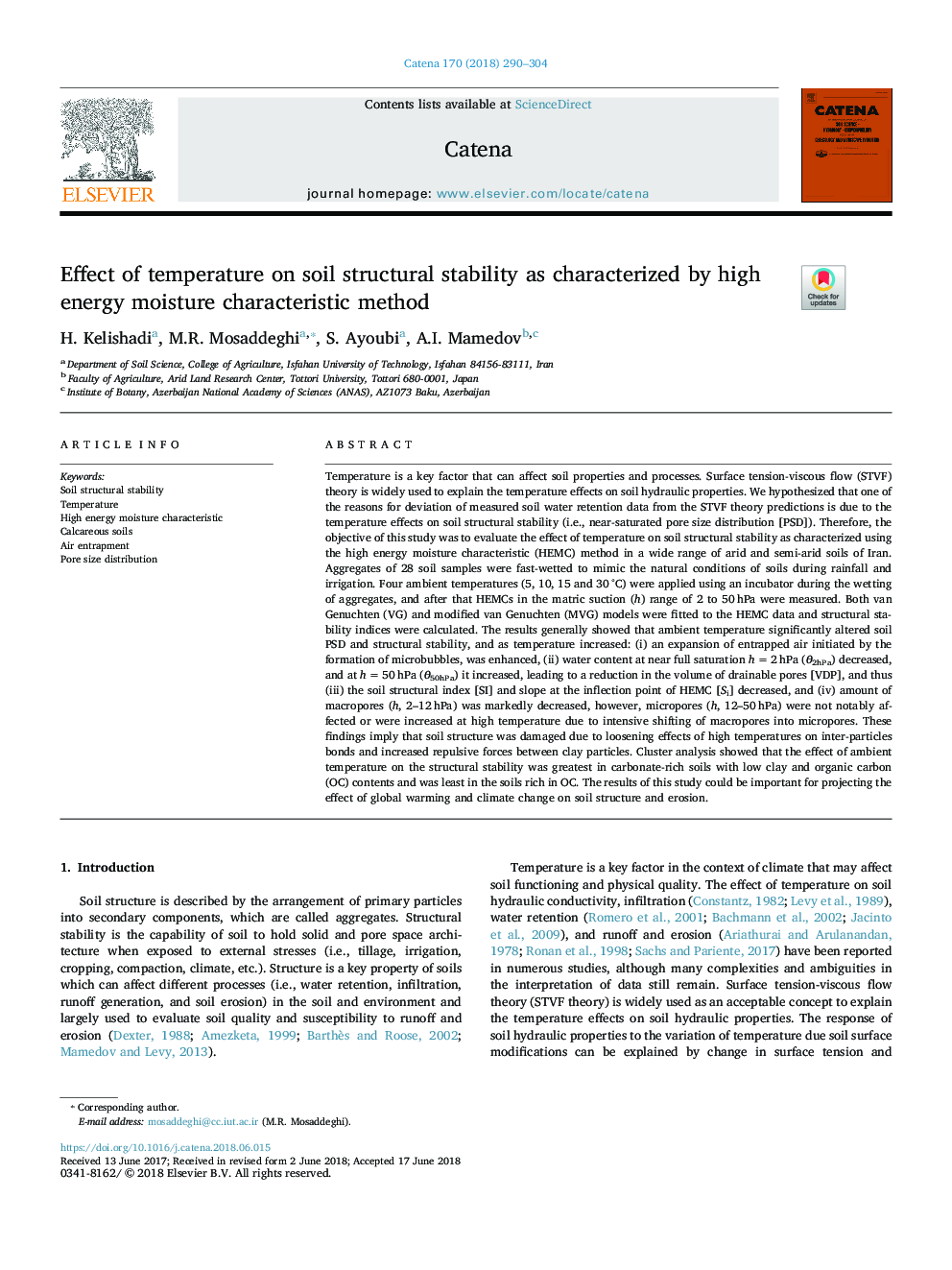| کد مقاله | کد نشریه | سال انتشار | مقاله انگلیسی | نسخه تمام متن |
|---|---|---|---|---|
| 8893420 | 1629184 | 2018 | 15 صفحه PDF | دانلود رایگان |
عنوان انگلیسی مقاله ISI
Effect of temperature on soil structural stability as characterized by high energy moisture characteristic method
ترجمه فارسی عنوان
اثر درجه حرارت بر پایداری سازه خاک به عنوان مشخصه روش رطوبت با انرژی
دانلود مقاله + سفارش ترجمه
دانلود مقاله ISI انگلیسی
رایگان برای ایرانیان
کلمات کلیدی
پایداری ساختاری خاک درجه حرارت، ویژگی رطوبت بالا انرژی، خاک های آهکی، گرفتگی هوا، توزیع اندازه پورت،
موضوعات مرتبط
مهندسی و علوم پایه
علوم زمین و سیارات
فرآیندهای سطح زمین
چکیده انگلیسی
Temperature is a key factor that can affect soil properties and processes. Surface tension-viscous flow (STVF) theory is widely used to explain the temperature effects on soil hydraulic properties. We hypothesized that one of the reasons for deviation of measured soil water retention data from the STVF theory predictions is due to the temperature effects on soil structural stability (i.e., near-saturated pore size distribution [PSD]). Therefore, the objective of this study was to evaluate the effect of temperature on soil structural stability as characterized using the high energy moisture characteristic (HEMC) method in a wide range of arid and semi-arid soils of Iran. Aggregates of 28 soil samples were fast-wetted to mimic the natural conditions of soils during rainfall and irrigation. Four ambient temperatures (5, 10, 15 and 30â¯Â°C) were applied using an incubator during the wetting of aggregates, and after that HEMCs in the matric suction (h) range of 2 to 50â¯hPa were measured. Both van Genuchten (VG) and modified van Genuchten (MVG) models were fitted to the HEMC data and structural stability indices were calculated. The results generally showed that ambient temperature significantly altered soil PSD and structural stability, and as temperature increased: (i) an expansion of entrapped air initiated by the formation of microbubbles, was enhanced, (ii) water content at near full saturation hâ¯=â¯2â¯hPa (θ2hPa) decreased, and at hâ¯=â¯50â¯hPa (θ50hPa) it increased, leading to a reduction in the volume of drainable pores [VDP], and thus (iii) the soil structural index [SI] and slope at the inflection point of HEMC [Si] decreased, and (iv) amount of macropores (h, 2-12â¯hPa) was markedly decreased, however, micropores (h, 12-50â¯hPa) were not notably affected or were increased at high temperature due to intensive shifting of macropores into micropores. These findings imply that soil structure was damaged due to loosening effects of high temperatures on inter-particles bonds and increased repulsive forces between clay particles. Cluster analysis showed that the effect of ambient temperature on the structural stability was greatest in carbonate-rich soils with low clay and organic carbon (OC) contents and was least in the soils rich in OC. The results of this study could be important for projecting the effect of global warming and climate change on soil structure and erosion.
ناشر
Database: Elsevier - ScienceDirect (ساینس دایرکت)
Journal: CATENA - Volume 170, November 2018, Pages 290-304
Journal: CATENA - Volume 170, November 2018, Pages 290-304
نویسندگان
H. Kelishadi, M.R. Mosaddeghi, S. Ayoubi, A.I. Mamedov,
